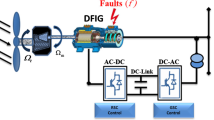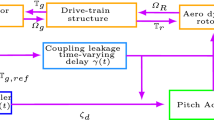Abstract
This paper presents a novel robust fault reconfiguration scheme based on optimized Takagi–Sugeno (T–S) fuzzy model and nonsingular terminal sliding mode observer (NTSMO) with adaptive law for micro-gas turbine (MGS). An optimized T–S fuzzy model is introduced because it can approximate any nonlinear model with arbitrary precision, and an improved imperial competition algorithm (ICA) using adaptive reform probability is proposed to improve the accuracy of the model. A linear transformation method is introduced to decouple the fault and disturbance of the system. The nonsingular terminal sliding mode observer is designed to reconstruct actuator fault and disturbance with unknown upper bound of a change rate, in which an adaptive law is introduced to update the sliding mode gain in real-time to eliminate the influence of fault, disturbance and modeling uncertainty. Simulations in Matlab/Simulink show high reconfiguration accuracy and high-speed of the proposed method despite of the presence of fault, disturbance and modeling uncertainty.










Similar content being viewed by others
Explore related subjects
Discover the latest articles and news from researchers in related subjects, suggested using machine learning.References
Benato, A., Stoppato, A., Mirandola, A., Del Medico, M.: Design and off-design analysis of an ORC coupled with a micro-gas turbine. Energy Proced 129, 551–558 (2017). https://doi.org/10.1016/j.egypro.2017.09.192
Talluri, L., Fiaschi, D., Neri, G., Ciappi, L.: Design and optimization of a Tesla turbine for ORC applications. Appl. Energy 226, 300–319 (2018). https://doi.org/10.1016/j.apenergy.2018.05.057
Kalantar, M., Mousavi, G.: Dynamic behavior of a stand-alone hybrid power generation system of wind turbine, microturbine, solar array and battery storage. Appl. Energy 87(10), 3051–3064 (2010). https://doi.org/10.1016/j.apenergy.2010.02.019
Rodriguez-Martinez, A., Garduno-Ramirez, R., Vela-Valdes, L.G.: PI fuzzy gain-scheduling speed control at startup of a gas-turbine power plant. IEEE Trans. Energy Convers. 26(1), 310–317 (2011). https://doi.org/10.1109/tec.2010.2081991
Nikpey, H., Assadi, M., Breuhaus, P., Mørkved, P.T.: Experimental evaluation and ANN modeling of a recuperative micro gas turbine burning mixtures of natural gas and biogas. Appl. Energy 117, 30–41 (2014). https://doi.org/10.1016/j.apenergy.2013.11.074
Mazzoletti, M.A., Bossio, G.R., De Angelo, C.H., Espinoza-Trejo, D.R.: A model-based strategy for interturn short-circuit fault diagnosis in PMSM. IEEE Trans. Industr. Electron. 64(9), 7218–7228 (2017). https://doi.org/10.1109/tie.2017.2688973
He, M., He, D.: Deep learning based approach for bearing fault diagnosis. IEEE Trans. Ind. Appl. 53(3), 3057–3065 (2017). https://doi.org/10.1109/tia.2017.2661250
Frank, P.M.: Fault diagnosis in dynamic systems using analytical and knowledge-based redundancy: a survey and some new results. Automatica. 26(3), 459–474 (1990). https://doi.org/10.1016/0005-1098(90)90018-d
Zhao, Z., Yang, Y., Ding, S.X., Li, L.: Fault-tolerant control for systems with model uncertainty and multiplicative faults. IEEE Trans. Syst. Man Cybern. 50(2), 514–524 (2020). https://doi.org/10.1109/tsmc.2017.2759144
Chen, W., Chen, W.-T., Saif, M., Li, M.-F., Wu, H.: Simultaneous fault isolation and estimation of lithium-ion batteries via synthesized design of Luenberger and Learning Observers. IEEE Trans. Control Syst. Technol. 22(1), 290–298 (2014). https://doi.org/10.1109/tcst.2013.2239296
Salehi, R., Vossoughi, G., Alasty, A.: A second-order sliding mode observer for fault detection and isolation of turbocharged SI engines. IEEE Trans. Industr. Electron. 62(12), 7795–7803 (2015). https://doi.org/10.1109/tie.2015.2448693
Liu, Z., He, H.: Sensor fault detection and isolation for a lithium-ion battery pack in electric vehicles using adaptive extended Kalman filter. Appl. Energy 185, 2033–2044 (2017). https://doi.org/10.1016/j.apenergy.2015.10.168
Mohammadi, A., Tavakoli, M., Marquez, H.J., Hashemzadeh, F.: Nonlinear disturbance observer design for robotic manipulators. Control Eng. Pract. 21(3), 253–267 (2013). https://doi.org/10.1016/j.conengprac.2012.10.008
Ginoya, D., Shendge, P.D., Phadke, S.B.: Sliding mode control for mismatched uncertain systems using an extended disturbance observer. IEEE Trans. Industr. Electron. 61(4), 1983–1992 (2014). https://doi.org/10.1109/tie.2013.2271597
Boskovic, J.D., Bergstrom, S.E., Mehra, R.K.: Robust integrated flight control design under failures, damage, and state-dependent disturbances. J. Guid. Contr. Dyn. 28(5), 902–917 (2005). https://doi.org/10.2514/1.11272
Alwi, H., Edwards, C., Marcos, A.: Fault reconstruction using a LPV sliding mode observer for a class of LPV systems. J. Franklin Inst. 349(2), 510–530 (2012). https://doi.org/10.1016/j.jfranklin.2011.06.026
Kumar, S.R., Rao, S., Ghose, D.: Nonsingular terminal sliding mode guidance with impact angle constraints. J Guid Cont. Dyn. 37(4), 1114–1130 (2014). https://doi.org/10.2514/1.62737
Wang, J., Yang, J., Wu, B., Li, S., Li, Q.: Extended state observer-based sliding mode control for PWM-based DC–DC buck power converter systems with mismatched disturbances. IET Control Theory Appl. 9(4), 579–586 (2015). https://doi.org/10.1049/iet-cta.2014.0220
Cui, R., Chen, L., Yang, C., Chen, M.: Extended state observer-based integral sliding mode control for an underwater robot with unknown disturbances and uncertain nonlinearities. IEEE Trans. Industr. Electron. 64(8), 6785–6795 (2017). https://doi.org/10.1109/tie.2017.2694410
Zheng, J., Wang, H., Man, Z., Jin, J., Fu, M.: Robust motion control of a linear motor positioner using fast nonsingular terminal sliding mode. IEEE/ASME Trans. Mechatron. 20(4), 1743–1752 (2015). https://doi.org/10.1109/tmech.2014.2352647
K, S., Jianbin, Q., Karimi, H.R., Fu, Y.: Event-Triggered Robust Fuzzy Adaptive Finite-Time Control of Nonlinear Systems with Prescribed Performance. IEEE Transactions on Fuzzy Systems, 1-1 (2020). https://doi.org/10.1109/tfuzz.2020.2979129
Lan, J., Patton, R.J.: Integrated design of fault-tolerant control for nonlinear systems based on fault estimation and T–S Fuzzy Modeling. IEEE Trans. Fuzzy Syst. 25(5), 1141–1154 (2017). https://doi.org/10.1109/TFUZZ.2016.2598849
Pechloff, A.N., Laschka, B.: Small disturbance Navier–Stokes method: efficient tool for predicting unsteady air loads. Journal of Aircraft 43(1), 17–29 (2006). https://doi.org/10.2514/1.14350
Sirca, G.F., Adeli, H.: System identification in structural engineering. Scientia Iranica 19(6), 1355–1364 (2012). https://doi.org/10.1016/j.scient.2012.09.002
Gou, X.Z., Zhou, W.X., Huang, J.Q.: Component-level modeling technology for variable cycle engine. J. Aerosp. Power 28(1), 104–111 (2013)
Meda-Campana, J.A., Grande-Meza, A., de Jesus Rubio, J., Tapia-Herrera, R., Hernandez-Cortes, T., Curtidor-Lopez, A.V., Paramo-Carranza, L.A., Cazares-Ramirez, I.O.: Design of stabilizers and observers for a class of multivariable T–S fuzzy models on the basis of new interpolation functions. IEEE Trans. Fuzzy Syst. 26(5), 2649–2662 (2018). https://doi.org/10.1109/tfuzz.2017.2786244
Zhu, X., Pedrycz, W., Li, Z.: A design of granular Takagi-Sugeno fuzzy model through the synergy of fuzzy subspace clustering and optimal allocation of information granularity. IEEE Trans. Fuzzy Syst. 26(5), 2499–2509 (2018). https://doi.org/10.1109/tfuzz.2018.2813314
Li, L., Chadli, M., Ding, S.X., Qiu, J., Yang, Y.: Diagnostic observer design for T–S fuzzy systems: application to real-time-weighted fault-detection approach. IEEE Trans. Fuzzy Syst. 26(2), 805–816 (2018). https://doi.org/10.1109/tfuzz.2017.2690627
Gharavi, H., Ardehali, M.M., Ghanbari-Tichi, S.: Imperial competitive algorithm optimization of fuzzy multi-objective design of a hybrid green power system with considerations for economics, reliability, and environmental emissions. Renew. Energy 78, 427–437 (2015). https://doi.org/10.1016/j.renene.2015.01.029
Chen, M.-H., Chen, S.-H., Chang, P.-C.: Imperial competitive algorithm with policy learning for the traveling salesman problem. Soft. Comput. 21(7), 1863–1875 (2015). https://doi.org/10.1007/s00500-015-1886-z
Bayareh, M., Mohammadi, M.: Multi-objective optimization of a triple shaft gas compressor station using Imperialist Competitive Algorithm. Appl. Therm. Eng. 109, 384–400 (2016). https://doi.org/10.1016/j.applthermaleng.2016.08.089
Razmjooy, N., Ramezani, M., Ghadimi, N.: Imperialist competitive algorithm-based optimization of neuro-fuzzy system parameters for automatic red-eye removal. Int. J. Fuzzy Syst. 19(4), 1144–1156 (2017). https://doi.org/10.1007/s40815-017-0305-2
Sun, S., Wei, X., Zhang, H., Karimi, H.R., Han, J.: Composite fault-tolerant control with disturbance observer for stochastic systems with multiple disturbances. J. Franklin Inst. 355(12), 4897–4915 (2018). https://doi.org/10.1016/j.jfranklin.2018.05.016
Han X, Fridman E, Spurgeon SK. Sliding mode observer for robust fault reconstruction of time delay systems. 2016. 10.1007/978-3-319-18072-4_9.
Acknowledgements
This work is supported by the National Natural Science Foundation of China [Grant Number: 51876089], and the Fundamental Research Funds for the Central Universities [Grant Number: kfjj20190205].
Author information
Authors and Affiliations
Corresponding author
Rights and permissions
About this article
Cite this article
Ma, L., Xiao, L., Meng, Z. et al. Robust Adaptive Fault Reconfiguration for Micro-gas Turbine Based on Optimized T–S Fuzzy Model and Nonsingular TSMO. Int. J. Fuzzy Syst. 22, 2204–2222 (2020). https://doi.org/10.1007/s40815-020-00917-7
Received:
Revised:
Accepted:
Published:
Issue Date:
DOI: https://doi.org/10.1007/s40815-020-00917-7




